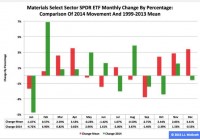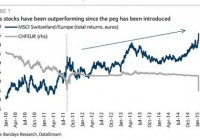Industrial Metals ETFs Investing 101
A stronger greenback, falling oil prices and an economic slowdown in China have lately emerged as major headwinds for the global metal industry. Moreover, excess supply has been a perennial problem for the industry. Iron ore has lost 50% of its value in 2014, the biggest annual decline in at least five years, impacted by excessive inventory along with abundant supply and slow economic growth in China. Global steel production has also been weak, mainly dragged down by a slowdown in China’s output, which affected demand for iron ore, its main ingredient. The low prices have squeezed margins of iron producers leading to the cancellation or suspension of mining projects. Moreover, softness in China amid an oversupply had led to a decline in copper prices in 2014. Copper prices further dipped to a four-year low in November end to $2.861 per pound on falling oil prices. Overall, copper fared the worst among all industrial metals, with prices declining 11% through the year. On the other hand, during 2014, the global aluminum industry went through a substantial change to correct the supply-demand imbalance. Major aluminum producers like Rusal and Alcoa Inc. (NYSE: AA ) cut their aluminum production, resulting in tightening of aluminum supply, which sent the metal’s prices northward. However, in the last months of 2014, falling oil prices and weak industrial data from China have led to a drop in aluminum prices. Aluminum is an energy intensive industry, with energy costs accounting for nearly 30% of the total cost of production. Falling oil prices tend to have a deflationary effect on aluminum. Nevertheless, aluminum prices ended the year with a 13% gain, higher than January levels. What’s in Store? Iron : The threat of oversupply looms large over the iron ore industry as major producers, Rio Tinto, BHP Billiton Ltd. (NYSE: BHP ), Vale S.A. (NYSE: VALE ) and Fortescue Metals Group Ltd. ( OTCQX:FSUGY ), continue to ramp up production. Australia, the world’s top exporter, cut its iron ore price estimate for next year by 33% as the surging output will outpace Chinese demand growth, leading to a supply glut. Global apparent steel use is expected to grow 2% in 2015 to reach 1,594 Mt. Softness in steel demand in China will continue to be a drag on the same. China is the largest consumer of iron ore, accounting for around 60% of the global seaborne market. Thus, the mismatch between the excess supply and demand for iron ore will keep iron ore prices subdued in the near term. Aluminum : Aluminum consumption is expected to improve on a global basis spurred by the automotive and packaging industries, its key consumer markets. The airline industry is also expected to boost demand for the metal. Following China, which accounts for over 40% of the global aluminum consumption, India appears promising given its current low level of aluminum consumption and high urban population growth. With demand remaining strong and the industry pulling in the reins on supply, the aluminum market is likely to witness deficits for a prolonged period. This will support high aluminum prices going forward. Copper : The copper market seems to be shifting into supply surplus. In the near term, prices will be influenced by economic activity in the U.S. and other industrialized countries. Revival in demand from China will also act as a catalyst. Notwithstanding the current volatility in prices, we have a long-term bullish stance on copper, supported by its widespread use in transportation, manufacturing and construction, limited supplies from existing mines and the absence of new significant development projects. To Sum Up A revival in the Chinese economy on the back of policy support and correction of the supply-demand imbalance will be instrumental in driving growth in the industry, while projected earnings growth for 2015 instills optimism in the same. ETFs to Tap the Sector An ETF approach can help spread out assets among a variety of companies and reduce company-specific risk at a very low cost. There are currently two ETFs available to play this sector. SPDR S&P Metals & Mining ETF (NYSEARCA: XME ) Launched in Jun 2006, XME seeks to replicate the S&P Metals and Mining Select Industry Index. The S&P Metals & Mining Select Industry Index represents the metals and mining sub-industry portion of the S&P Total Market Index. The fund currently has AUM of $390.4 million. XME has a trading volume of roughly 1.6 million shares a day, suggesting little or no extra cost in the form of bid/ask spreads. The ETF is a low-cost choice, charging a net expense ratio of 35 basis points a year, while the dividend yield is 2.30% currently. The fund currently holds 35 stocks in its basket, with only 38.12% of assets in the top 10 holdings. From a commodities perspective, the product is heavily weighted toward steel with 41% sector weightage, followed by coal and consumable fuels (17%), diversified metal and mining (13%), aluminum (11%), silver (7%), gold (7%) and precious metals and minerals (4%). Among individual holdings, top stocks in the ETF include Hecla Mining Co. (NYSE: HL ), TimkenSteel Corporation (NYSE: TMST ) and Compass Minerals International Inc. (NYSE: CMP ) with asset allocation of 4.19%, 4.14% and 3.88%, respectively. iShares MSCI Global Metals & Mining Producers ETF (NYSEARCA: PICK ) The ETF seeks to match the price and yield performance of MSCI ACWI Select Metals & Mining Producers Ex Gold & Silver Investable Market Index. This index measures the equity performance of companies in both developed and emerging markets that are primarily involved in the extraction and production of diversified metals, aluminum, steel and precious metals and minerals, excluding gold and silver. Launched in Jan 2012, the fund has so far attracted AUM of $158 million. It has a trading volume of roughly 16,257 shares a day. The ETF is currently charging a net expense ratio of 39 basis points a year, with a dividend yield of 2.91%. The fund currently holds 209 stocks with 98% sector weightage toward basic materials. The fund allocates nearly 50% of the assets in the top 10 firms, which suggests that company-specific risk is somewhat high, as the top 10 holdings dominate half of the returns. Among individual holdings, top three stocks in the ETF include BHP Billiton Limited ( BHP ), Rio Tinto plc (NYSE: RIO ) and Glencore Plc (GLEN.L) with asset allocation of 10.81%, 8.4% and 6.76%, respectively. The fund is widely diversified across various countries, and Australia tops the list, holding 24.7% of the fund, followed by the United States (10.9%) and United Kingdom (9.96%). These three nations make up for nearly 46% of the assets.

